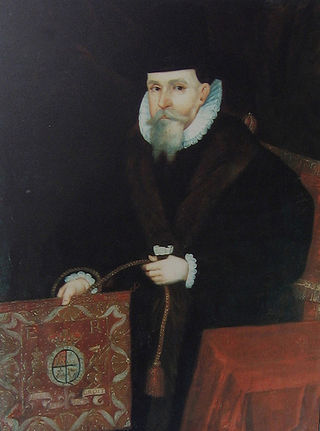
Adam Loftus was an English Anglican bishop who was Archbishop of Armagh, and later Dublin, and Lord Chancellor of Ireland from 1581. He was also the first Provost of Trinity College Dublin.

The Diocese of Galway, Kilmacduagh and Kilfenora is a Latin Church diocese of the Catholic Church in the west of Ireland. It is in the ecclesiastical province of Tuam and is subject to the Metropolitan Archdiocese of Tuam. The deanery of Kilfenora, previously a diocese in its own right, lies in the ecclesiastical province of Cashel. The ordinary is Bishop Michael Duignan who was appointed on 11 February 2022.
The Archbishopric of Tuam existed from the mid twelfth century until 1839, with its seat at Tuam.
The Bishop of Kilfenora was a distinct episcopal title which took its name from the village of Kilfenora in County Clare in the Republic of Ireland. In both the Church of Ireland and the Roman Catholic Church, the title is now united with other bishoprics.

The Bishop of Annaghdown is an episcopal title which takes its name after the small village of Annaghdown in County Galway, Republic of Ireland.
John McEvilly (1818–1902) was an Irish Roman Catholic Church clergyman who served as the Archbishop of Tuam from 1881 to 1902.
John de Burgh, or de Burgo or Burke, was an Irish Roman Catholic clergyman who served as Vicar Apostolic (1629–41) and Bishop of Clonfert (1642–47), and Archbishop of Tuam (1647–67).
Tomás Ó Maolalaidh was an Irish churchman who became Bishop of Clonmacnoise (c.1509-1514) and Archbishop of Tuam (1514–1536).

Power Le Poer Trench (1770–1839) was an Anglican clergyman who served in the Church of Ireland as firstly Bishop of Waterford and Lismore, then Bishop of Elphin and finally Archbishop of Tuam.
Edward Dillon (1739–1809) was an Irish clergyman who served as a Roman Catholic prelate in Ireland during the late 18th and early 19th centuries.
William Daniel D.D. was an Irish clergyman who served as the Church of Ireland Archbishop of Tuam from 1609 until his death in 1628.
Arthur O'Friel was an Irish Roman Catholic clergyman who attempted, but failed, to get possession of the archbishopric of Tuam in the 16th century.
William Mullally, whose family name also appears as Ó Mullally, O'Mullally, Lally, Laly or Lawly, was Archbishop of Tuam in the Church of Ireland from 1573 to his death in 1595.

Joseph Deane Bourke, 3rd Earl of Mayo was an Irish peer and cleric who held several high offices in the Church of Ireland including Bishop of Ferns and Leighlin (1772–82) and Archbishop of Tuam (1782–94).
Ambrose O'Madden was an Irish prelate of the Roman Catholic Church. He served as the Bishop of Clonfert from 1713 to 1715.
The Dean of Killaloe is based at the Cathedral Church of St Flannan in Killaloe in the united diocese of Limerick, Killaloe and Ardfert within the Church of Ireland. The Dean of Killaloe is also Dean of St Brendans, Clonfert, Dean of Kilfenora, and both Dean and Provost of Kilmacduagh.
Patrick MacMahon, O.F.M. was Bishop of Ardagh in Ireland, recognised at various times by both the Roman Catholic church in Ireland and the Church of Ireland. His appointment to the see was approved by the Vatican on 14 November 1541. The Reformation in Ireland had begun, but there was not yet a definitive break between, on the one hand, the hierarchy recognised by the Roman Curia and, on the other hand, the established church recognised by the Dublin Castle administration of the English king Henry VIII. The Diocese of Ardagh was in the Annaly region of the Farrell clan, of whom Richard O'Ferrall had secured the temporalities of the diocese in July 1541. George Cromer, the Church of Ireland Archbishop of Armagh and primate of all Ireland, recognised O'Ferrall and had him consecrated on 22 April 1542. Cromer's successor George Dowdall on 15 May 1544 appointed MacMahon instead as a suffragan bishop inter Hibernicos. When the Catholic Queen Mary I succeeded to the throne in 1553, papal supremacy was recognised and MacMahon received the temporalities of Ardagh. While Monahan says that Ardagh was vacant in the Church of Ireland after the accession of Elizabeth I, others regard MacMahon as retaining his place in both hierarchies. A possibly forged papal bull, dated 1568, deprives MacMahon of his see for simony, non-residence, and neglect of the cathedral. A putative 1572 letter from Marshalsea from a former bishop "Malachy" of Ardagh, abjuring "papistical superstition" and promising loyalty to Elizabeth, may if genuine be from MacMahon. MacMahon's death is inferred to have occurred either before 5 November 1572, when a successor was appointed in the Church of Ireland, or else during 1575, before Richard Brady was appointed by the Vatican on 23 January 1576.
Bodkin is a surname. Notable people with the surname include:
Patrick Walsh was an Irish prelate who served as the Bishop of Waterford and Lismore from 1551 to 1578.
Randolph Barlow, was an Anglican archbishop. He was made Pembroke College fellow at Cambridge University in 1593; attained Master of Arts in 1594; awarded Doctor of Divinity in 1600; took holy orders and later served in the Church of Ireland as the Archbishop of Tuam from 1629 to 1638.





